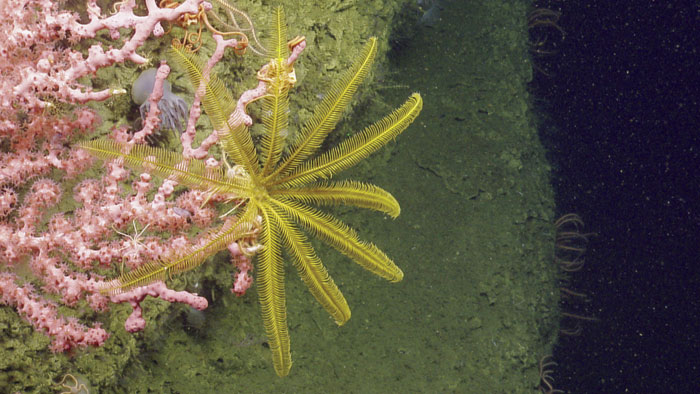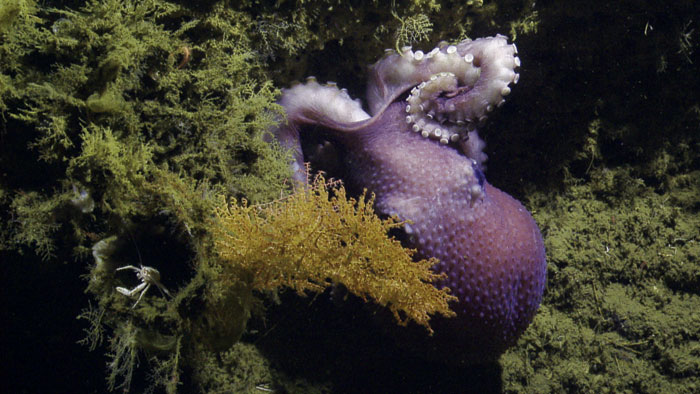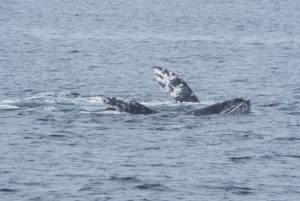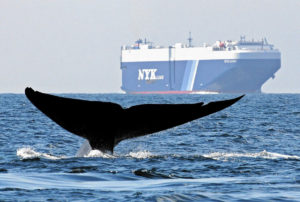Photos courtesy Ocean Exploration Trust
An exploration group deployed robots to peer into parts of the deep sea beneath the Cordell Bank National Marine Sanctuary for the first time this August, beaming back live video of massive corals, giant-eyed octopuses, and overgrown canyon ledges like vast undersea hanging gardens.
The private nonprofit exploration ship Nautilus and a team of scientists spent three days in the roughly 1,300-square-mile sanctuary north of the Golden Gate, using two unmanned submersibles to illuminate and explore the seafloor. Moving slowly in near-freezing water and total darkness, the ROVs hovered over the muddy bottom in previously unexplored places like Bodega Canyon, a 5,200-foot-deep chasm approximately 20 miles west of Bodega Bay. Octopuses and fish darted through the headlight beams. Cliffs, ledges, and rock formations rose out of the gloom. Yet close in under the lights was a world of surprising color: pink anemones and glittering red hydroids, giant orange sea stars and crabs, and billowing purple and yellow coral.
“We were the first eyes to look at it, as far as we know,” said Jennifer Stock, an outreach and education coordinator with the sanctuary. “The energy and excitement was pretty high.”
Stock said the corals in particular grabbed everyone’s attention. Scientists used the robot’s arm to take samples of 22 kinds of coral, only a handful of which were known to live in the sanctuary before the cruise. One of them, a kind of corkscrew coral, has never been recorded on the West Coast, she said.
The corals grow in a stunning variety of shapes, and many are massive relative to the tropical corals most people are familiar with. They looked in places like stunted trees, branches reaching out into the black water around them, and like trees, they provide structure around which other life might gather. Fish clustered nearby, and ratfish swam languidly away from the lights as the rovers approached. Spiny, filter-feeding brittle stars hung from the upper branches of the corals like pennants on a ship mast. Multi-color sponges and bryozoans grew around the bases.

Corals, which grow slowly and live for hundreds of years in the cold, also provide scientists a valuable window into how the deep ocean has changed over time. Researchers collected samples, and can analyze the chemistry of the coral to reconstruct the environment they’ve lived in. The research can help determine how life in Cordell Bank has responded to ocean acidification and climate change.
Whale and bird watchers are familiar with the incredible richness of life to be seen in the Cordell Bank sanctuary boundaries, Stock said, but it’s something else to see what’s happening a mile beneath the surface. “It was so satisfying to go down below, and get a pretty good idea that at those depths there’s this incredible new world,” she said.
And even in urban, tech-dominated coastal Northern California, the deep ocean remains that incredible new world. Stock said that despite sophisticated seafloor imaging techniques, she and others worried the rovers would get to the bottom and see nothing but mud for days. “We were really thrilled to see hard substrate,” she said.

Scientists watching the expedition, which was streamed live via the internet, gleefully shared observations and discoveries on social media. “The deep sea is completely amazing,” said Tessa Hill, an ocean climate scientist at the UC Davis Bodega Marine Lab. “It will never get old to me. There’s so little we’ve seen that every day is a new discovery or a new species, or we’ve never seen that color or these things together. We know more about the surface of the moon.”
Hill tuned her summer oceanography class into the live stream to have undergraduates watch the seafloor flow by, and talk to the scientists on the ship. The students asked a lot of questions, she said, to which the answer is still “we don’t know.” That’s both exciting and alarming — there’s an incredible new world right off our coast, rich with life and waiting to be explored — and we might be affecting it before we get to explore it. Stock said one of the first things the rovers came across in Bodega Canyon was a plastic water bottle, lying in the mud 6,000 feet below the surface. Climate change is already affecting the deep sea and everything that lives there.
“We haven’t even documented what it was like,” Hill said. “It’s changing before we have a chance to discover what’s there. So that puts a time pressure on all of us.”

Much of the cruise took place in waters that were part of an expansion of the Cordell Bank National Marine Sanctuary in 2015, and so fell under a presidential order to review national marine sanctuaries and marine national monuments created or expanded in the last decade. Although several other sanctuaries are now scheduled to be re-opened to fishing or mineral extraction, Interior Secretary Ryan Zinke did not recommend changes to Cordell Bank.
Find a calendar of upcoming Nautilus expeditions and view live explorations at nautiluslive.org.





